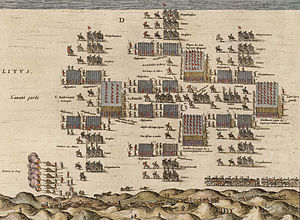| Army of Flanders | |
|---|---|
 The Army of Flanders' deployment for the Battle of Nieuwpoort (1600). | |
| Active | 1567–1706 (dissolution) |
| Disbanded | 1706 |
| Country | |
| Allegiance | King of Spain as hereditary prince of the Low Countries |
| Branch | Spanish Army |
| Type | Tercio |
| Role | Security, control, and defense of the Spanish Netherlands |
| Size | 10,000[1] (1567) 86,235[2] (1574) 49,765[2] (1607) 77,000[3] (1639) |
| Garrison/HQ | Brussels |
| Commanders | |
| Notable commanders | Duke of Alba Julián Romero Sancho Dávila Duke of Parma Ambrosio Spínola Cardinal-Infante Ferdinand Marqués de Assentar Sebastian Fernandez de Medrano |

The Army of Flanders (Spanish: Ejército de Flandes Dutch: Leger van Vlaanderen) was a multinational army in the service of the kings of Spain that was based in the Spanish Netherlands during the 16th to 18th centuries. It was notable for being the longest-serving army of the period, being in continuous service from 1567 until its disestablishment in 1706 and taking part in numerous pivotal battles of the Dutch Revolt (1566–1609) and the Thirty Years' War (1618–1648). Because it employed or pioneered many developing military concepts more reminiscent of later military units, enjoying permanent, standing regiments (tercios), barracks, military hospitals and rest homes long before they were adopted in most of Europe, the Army of Flanders has been considered the world's de facto first modern professional standing army.[4] Sustained at huge cost and at significant distances from Spain via the Spanish Road, the Army of Flanders also became infamous for successive mutinies and its ill-disciplined activity on and off the battlefield, including the Sack of Antwerp in 1576.
- ^ Parker, El ejército de Flandes y el Camino Español, 1567–1659, p. 323
- ^ a b Parker, El ejército de Flandes y el Camino Español, 1567–1659, p. 315
- ^ Barratt (2016), p. 12.
- ^ Hale (1985), p. 67.